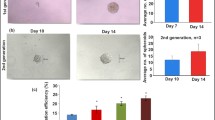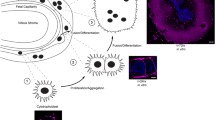Abstract
The role of differentiated trophoblast glycogen cells (GCs) in the ectoplacental cone (EPC) has not been elucidated yet. Recently, GC progenitors have been shown to be present from embryonic day 7.5 (E7.5), but glycogen is found in GC only from E10.5. Herein, we investigated the origin, localization and characterization of mouse GCs in EPC and their relationship with blood cells and trophoblast giant cells (TGCs) during placentation. Implantation sites (E5.5–E12.5) were processed for histological studies, histochemical detection (glycogen) and immunohistochemical staining (Ki67). Three-dimensional reconstruction of the EPC was obtained from suitably oriented embryos at E7.5. Our findings evidence that GCs are present and assembled in clusters from E6.5 to E12.5, and that they exhibit the classic vacuolated appearance and contain PAS-positive glycogen, which is amylase-sensitive and acetylation-resistant. In fact, only GCs were stained after acetylation, confirming unequivocally their presence in tissues. At E6.5, GCs showed numerous mitoses and vacuoles with scattered glycogen particles. At E7.5, GCs showed low numbers of mitoses and abundant vacuoles full of glycogen. During E7.5–E8.5, GCs were in close proximity to TGCs, and cells were intercalated by thin maternal blood spaces; placental GCs lost maternal blood contact during E9.5–E12.5. Our results indicate that GCs are originated and proliferate in the upper portion in the midregion of EPC at E6.5, and that at E7.5–E8.5 they show consistent glycogen deposits, which are likely metabolized to glucose. This compound may be directly transferred to circulating maternal blood, and used as a source of energy by GCs and TGCs during placentation.




Similar content being viewed by others
References
Adamson SL, Lu Y, Whiteley KJ, Holmyard D, Hemberger M, Pfarrer C, Cross JC (2002) Interactions between trophoblast cells and the maternal and fetal circulation in the mouse placenta. Dev Biol 250:358–373
Bouillot S, Rampon C, Tillet E, Huber P (2006) Tracing the glycogen cells with protocadherin 12 during mouse placenta development. Placenta 27:882–888
Bridgman J (1948) A morphological study of the development of the placenta of the rat: an outline of the development of the placenta of the white rat. J Morphol 83:61–85
Christie GA (1966) Implantation of the rat embryo: glycogen and alkaline phosphatases. J Reprod Fertil 12:279–294
Cross JC (2005) How to make a placenta: mechanisms of trophoblast cell differentiation in mice—a review. Placenta 26A:S3–S9
Georgiades P, Ferguson-Smith AC, Burton GJ (2002) Comparative developmental anatomy of the murine and human definitive placentae. Placenta 23:3–19
Katz SG (1995) Extracellular and intracellular degradation of collagen by trophoblast giant cells in acute fasted mice examined by electron microscopy. Tissue Cell 27:713–721
Katz SG (1998) Demonstration of extracellular acid phosphatase activity in the involuting, antimesometrial decidua in fed and acutely fasted mice by combined cytochemistry and electron microscopy. Anat Rec 252:1–7
Katz SG (2005) Extracellular breakdown of collagen by mice decidual cells. A cytochemical and ultrastructural study. Biocell 29:261–270
Katz S, Abrahamsohn PA (1987) Involution of the antimesometrial decidua in the mouse. An ultrastructural study. Anat Embryol 176:251–258
Lescisin KR, Varmuza S, Rossant J (1988) Isolation and characterization of a novel trophoblast-specific cDNA in the mouse. Genes Dev 2:1639–1646
Lison L (1960) Méthodes de digestion enzymatique. In: Lison L (ed) Histochimie et cytochimie animales: principes et méthodes, 2v 3ème ed. Gauthier-Villars, Paris, pp 748–749
McManus JFA (1946) Histological demonstration of mucin after periodic acid. Nature 158:202–202
McManus JFA, Cason JE (1950) Carbohydrate histochemistry studied by acetylation techniques: I. Periodic acid methods. J Exp Med 91:651–654
Mehrotra PK (1984) Blastocyst attachment and morphogenesis of ectoplacental cone in mouse. J Biosci 6(S2):43–52
Mehrotra PK (1988) Ultrastructure of mouse ectoplacental cone cells. Biol Struct Morphog 1:63–68
Müntener M, Hsu YC (1977) Development of trophoblast and placenta of the mouse. A reinvestigation with regard to the in vitro culture of mouse trophoblast and placenta. Acta Anat 98:241–252
Padykula HA, Richardson D (1963) A correlated histochemical and biochemical study of glycogen storage in the rat placenta. Am J Anat 112:215–241
Paffaro VA Jr, Bizinotto MC, Joazeiro PP, Yamada AT (2003) Subset classification of mouse uterine natural killer cells by DBA lectin reactivity. Placenta 24:479–488
Peel S, Bulmer D (1977) Proliferation and differentiation of trophoblast in the establishment of the rat chorio-allantoic placenta. J Anat 124:675–687
Redline RW, Chernicky CL, Tan HQ, Ilan J, Ilan J (1993) Differential expression of insulin-like growth factor-II in specific regions of the late (post day 9.5) murine placenta. Mol Reprod Dev 36:121–129
Simmons DG, Fortier AL, Cross JC (2007) Diverse subtypes and developmental origins of trophoblast giant cells in the mouse placenta. Dev Biol 304:567–578
Smith LJ (1966) Metrial gland and other glycogen containing cells in the mouse uterus following mating and through implantation of the embryo. Am J Anat 119:15–23
Spadacci-Morena DD, Katz SG (2001) Acute food restriction increases collagen breakdown and phagocytosis by mature decidual cells of mice. Tissue Cell 33:249–257
Teesalu T, Blasi F, Talarico D (1998) Expression and function of the urokinase type plasminogen activator during mouse hemochorial placental development. Dev Dyn 213:27–38
Welsh AO, Enders AC (1985) Light and electron microscopic examination of the mature decidual cells of the rat with emphasis on the antimesometrial decidua and its degeneration. Am J Anat 172:1–29
Welsh AO, Enders AC (1991) Chorioallantoic placenta formation in the rat: II. Angiogenesis and maternal blood circulation in the mesometrial region of the implantation chamber prior to placenta formation. Am J Anat 192:347–365
Zheng-Fischhöfer Q, Kibschull M, Schnichels M, Kretz M, Petrasch-Parwez E, Strotmann J, Reucher H, Lynn BD, Nagy JI, Lye SJ, Winterhager E, Willecke K (2007) Characterization of connexin31.1-deficient mice reveals impaired placental development. Dev Biol 312:258–271
Author information
Authors and Affiliations
Corresponding author
Electronic supplementary material
Below is the link to the electronic supplementary material.
Rights and permissions
About this article
Cite this article
Tesser, R.B., Scherholz, P.L.A., do Nascimento, L. et al. Trophoblast glycogen cells differentiate early in the mouse ectoplacental cone: putative role during placentation. Histochem Cell Biol 134, 83–92 (2010). https://doi.org/10.1007/s00418-010-0714-x
Accepted:
Published:
Issue Date:
DOI: https://doi.org/10.1007/s00418-010-0714-x




